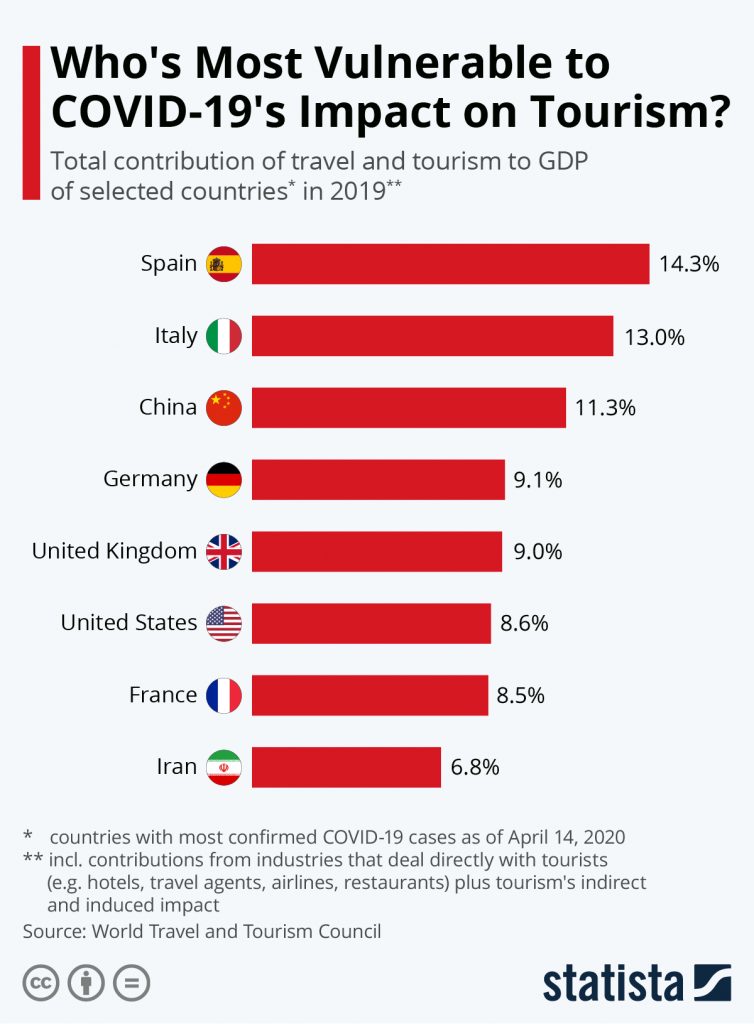COVID-19 has hurt the world’s economies. However, tourism-dependent countries are more vulnerable to economic fallout.
The number of confirmed COVID-19 is now past the two million mark as of the latest count.
Now in its fourth month of spread all over the world, COVID-19 has brewed up terrible days for the stock market, with some even being listed among the worst stock market crashes of the 21st century.
With a huge chunk of business operations put to a halt, the global economy is expected to suffer. This is especially true for countries whose incomes heavily depend on travel and tourism, now that people are required to stay indoors.
Which countries are the most vulnerable to the pandemic’s impact on tourism?
From our partners:
Compounding effects
Statista collected 2019 gross domestic product (GDP) data from the World Travel and Tourism Council (WTTC), selected countries with the highest number of COVID-19 cases as of this week and checked how much of the GDP of these countries come from travel and tourism.
The findings are summarised below:
Among the hardest-hit countries, Spain is the most vulnerable to COVID-19’s impact on tourism. Travel and tourism contributed a substantial 14.3% to their 2019 GDP. The latest count places Spain as the second heaviest-stricken country by COVID-19, with 182,816 confirmed cases.
Italy, the country with the third-highest number of confirmed COVID-19 cases right now is the second most vulnerable. At 13% of the 2019 GDP, the country is highly reliant on tourism for their annual income.
Even before the outbreak, Richter pointed out that Spain and Italy are already suffering high levels of public debt. These two also recorded unemployment rates which are the highest among the Organisation for Economic Co-operation and Development (OECD) member states.
With all these factors piled up, the destructive effect of COVID-19 is greatly compounded for these countries.
More highlights
The COVID-19 epicentre, China, is the third most vulnerable, with 11.3% of their 2019 GDP attributable to travel and tourism.
China has been gradually falling down in the rankings in terms of the number of confirmed cases the past few weeks. However, the effect of COVID-19 on its tourism sector will persist for as long as other countries haven’t fully contained the disease in their territories.
The United States has long overtaken China as the country with the highest number of confirmed cases. The April 17 tally shows that there are 648,788 known COVID-19 in the U.S.
However, unlike the other countries discussed so far, the U.S. isn’t as heavily dependent on tourism. In 2019, only 8.6% of their GDP was contributed by the industry. This does not mean that the effect isn’t bad — 16.8 million jobs in the U.S. are linked to the tourism sector.
Income from the tourism sector, Richter noted, comes from the contributions from hotels, travel agents, airlines, and restaurants, among others. On top of this, tourists also bring in a lot of revenue during their stay in tourist destinations.
With the number of confirmed cases still growing each day, it appears that it will take a long time before the tourism sector can go back to business as usual.














